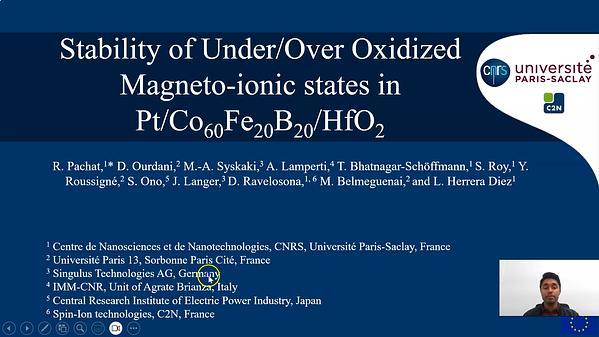Would you like to see your presentation here, made available to a global audience of researchers?
Add your own presentation or have us affordably record your next conference.
Voltage-driven ion transport modulation of magnetism (magneto-ionics) represents a significant breakthrough to enhance energy efficiency in magnetically-actuated devices. Particularly, voltage-driven oxygen ion motion in Co3O4 allows for voltage-controlled On−Off ferromagnetism, since Co3O4 (paramagnetic: Off) can be partially reduced to Co (ferromagnetic: On) by voltage actuation. This can be afterwards reversed by applying a voltage of the opposite polarity (1). The way the electric field is applied has a strong impact in the room temperature magneto-ionic motion. Specifically, in electrolyte-gated 100 nm-thick paramagnetic Co3O4 films, the oxygen magneto-ionic motion can be sped up by an order of magnitude (from 1000 to 100 s) applying the electric field through an electrochemical capacitor configuration (i.e., using, as a working electrode, an underlying conducting buffer layer beneath the Co3O4 film) rather than using an electric-double-layer transistor-like configuration (i.e., placing the electric contact at one side of the Co3O4 film as a working electrode). This is due to the better uniformity and larger strength of the electric field in the capacitor design (1,2). However, ion motion at room temperature is still too slow for applications. By reducing the Co3O4 film thickness down to 15 nm, sub-10 s ON-OFF ferromagnetism can be achieved in electrolyte-gated films (3). Remarkably, cumulative magneto-ionic effects can be generated by applying voltage pulses at frequencies as high as 100 Hz, which is the frequency at which dynamic effects of biological synapses occur. Magneto-ionics in Co3O4 can then be used to emulate synapse functionalities, including plasticity, potentiation (magnetization increase) and depression (i.e., depletion of magnetization), voltage-controlled threshold activation of ferromagnetism (i.e., spike-magnitude dependence), and learning and forgetting capabilities. The former by means of spike-rate-dependent plasticity of the generated magnetization upon pulsed voltage actuation. These features demonstrate Co3O4 magneto-ionics can be used for the design of neuromorphic-like systems (3).
References:
(1) A. Quintana, E. Menéndez, M. O. Liedke, M. Butterling, A. Wagner, V. Sireus, P. Torruella, S. Estradé, F. Peiró, J. Dendooven, C. Detavernier, P. D. Murray, D. A. Gilbert, K. Liu, E. Pellicer, J. Nogues and J. Sort, Voltage-controlled ON−OFF ferromagnetism at room temperature in a single metal oxide film, ACS Nano 12 (2018) 10291–10300
(2) J. de Rojas, A. Quintana, A. Lopeandía, J. Salguero, J. L. Costa-Krämer, L. Abad, M. O. Liedke, M. Butterling, A. Wagner, L. Henderick, J. Dendooven, C. Detavernier, J. Sort and E. Menéndez, Boosting room-temperature magneto-ionics in a non-magnetic oxide semiconductor, Advanced Functional Materials 30 (2020) 2003704
(3) S. Martins, J. de Rojas, Z. Tan, M. Cialone, A. Lopeandía, J. Herrero-Martín, J. L. Costa-Krämer, E. Menéndez and J. Sort, Dynamic electric-field-induced magnetic effects in cobalt oxide thin films: towards magneto-ionic synapses, Nanoscale 14 (2022) 842–852
